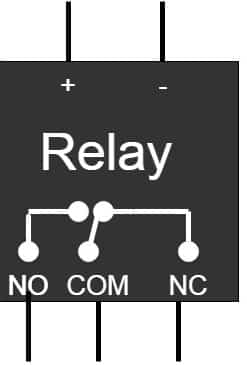In this post, we shall study the basic concept of the safety relay. The safety relay has more features than a normal relay. The relay is a very useful component. The relay is an electromechanical switch. The relay energizes when we supply voltage to the coil of the relay. After relay energization, the relay contacts change over.
Basics Concept of Relay
A standard relay consists of 5 terminals. The relay can have more than 5 terminals and even more depends on the application.
The input of the relay has two terminals- A positive supply point and a negative supply point. The coil of the relay has its connection at positive and negative terminals. The output of the relay has three contacts. These are;
- Common
- Normally-Open (NO) Contact
- Normally Closed (NC) Contact
When the relay is in a de-energized position ( When the coil of the relay does not receive the supply), the contact is between COM and NC. When we energize the relay by supplying voltage to its coil, the contact is between COM and NO.

The relay provides isolation between energizing voltage and output voltage which is routed through COM, NO, and NC. Thus, the fault in one circuit can not damage the controlling circuit and vice versa.
In an electromechanical relay the contacts COM, NO & NC may weld if the excess current flows through the contact. This may happen in the case of a fault in the circuit. In this situation, safety can not be ensured.
Limitation of normal relay
Though, it happens very rarely. However, after relay energization, the relay contacts do not changeover is very dangerous. The whole process gets disturbed causing damage to the equipment and it also causes financial loss on the part of production loss.
Safety has prime importance in automation and instrumentation. The failure of the safety devices may cause severe damage to equipment. Therefore, utmost care is required while designing the safety devices.
If we use an emergency switch at the input side and the output side of the relay to PLC input. In the case of the welded contacts of the relay, the PLC can not detect the contacts of the relay, even if we press the emergency push button.
This is the reason, why many European and American standards avoid the use of a standard relay in their control panel.
Now, here comes the concept of safety relay!
Safety Relay
The above-discussed limitation of the conventional electromechanical relay can be overcome by the use of the safety relay. We can use the safety relay in place of the normal relay. A safety relay has more advanced and technical features as compared to a normal relay. What other feature a safety relay has? We can use the safety relay in fail-safe mode.
Safety relay is more reliable and satisfies various SIL (safety Integrity Levels) applications.
Features of Safety Relay
A safety relay has a self-monitoring feature. The in-built self-monitoring of the relay checks the functionality of the relay. In the case of contact weld or jamming, the relay automatically turns off the circuit contact at both the input and output side.
The internal in-built self-monitoring circuit of the relay test the healthiness of the relay system in each on-off cycle. This test ensures the functionality of the relay in each on-off cycle. Safety relay can detect the fault if there are failures in the internals of the relay.
Safety relays can detect the following.
- Wire breaks
- Faulty relay
- Faulty safety Relay
- Short Circuit
- Open circuit
We can use the safety relay in combination with various safety relays for a particular application. This ensures the safe working of the machine.
The relay has a reset button just like a reset button in overload relays. The operator first finds the fault and after troubleshooting the fault the operator resets the fault.
The safety relay has a communication port( Ethernet, Modbus, etc.). Through the communication port, the important information is sent to PLC or other control equipment.
A safety relay has forcibly guided contacts. In the case of contacts welding or jamming, the forcibly guided system changes the contacts from their position. This way safety relay ensures safety.
This operation ensures that both NO and NC contacts move opposite with each other, as in normal operation.
One should first access the risk factor before choosing a safety relay. requires a sound. One can use ISO 12100 for the selection of safety relay.
Applications of Safety Relay
We use a safety relay for critical applications that require hardcore safety monitoring. The application examples are as follows.
- light curtains,
- safety mats,
- three-position devices,
- two-hand control devices,
- magnetic switches,
- emergency stop buttons,
- non-contact safety sensors,
- interlock safety switches etc.
For more details of the application of safety relay, pl read
Read Next :